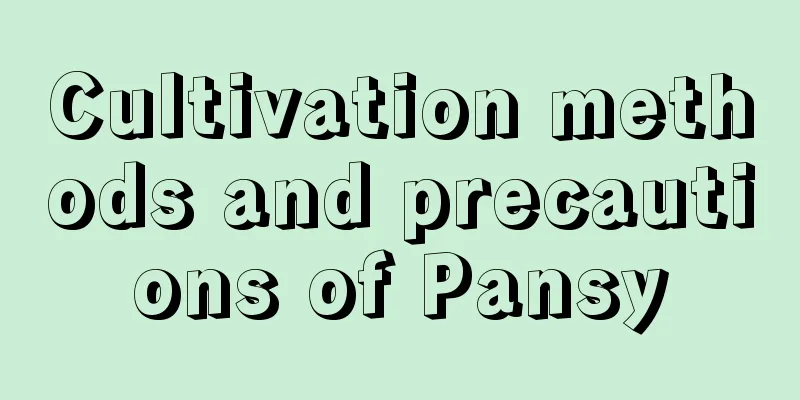Can I spray vinegar on Chinese cabbage if it has bugs? (Spraying rice vinegar on cabbage is good for increasing yield)

|
Spraying some vinegar on cabbage can supplement amino acids and some trace elements, which is beneficial for the cabbage to wrap the heart. However, vinegar should not be used casually. Pay attention to the concentration and the period of use, otherwise the taste will deteriorate. If the yield is good but the taste is bad, this cabbage is not what we want. Before talking about how to use vinegar, I would like to share with you some tips on increasing yield and preventing insects in a small area of the vegetable garden. Remember to save them for reference only! 1. Garlic + pepper + urea + waterThis method is suitable for vegetables grown in small areas such as vegetable gardens, and the effect is good. Families can try it to see the effect. It is recommended that farmers prepare a head of garlic and two peppers. We chop the peppers and then mash the garlic for later use. How to use: Garlic (1 head) + dried chilies (2) + urea (just a little, using its stickiness after dissolving in water) + water (3-4 kg). After making a double-liquid solution, filter it out with a strainer and spray it on the cabbage to prevent insects and increase production. It is suitable for use in your own small vegetable garden, convenient and saves trouble! 2. Eggshell + rice vinegarVegetables need calcium supplementation in the later stage, which can not only prevent dry core burning, but also prevent cracked fruits in the later stage. We can make calcium fertilizer at home, and we don’t have to buy it on the market. Preparation method: Choose 5 egg shells, crush them and add 1 tael of rice vinegar to extract the calcium in the egg shells. After standing for 2 hours, we dilute the filtrate into 200 times liquid and spray it to prevent the occurrence of dry heartburn. Eggshells contain calcium carbonate, while rice vinegar contains amino acids and trace elements, which can supplement nutrition for cabbage, promote growth, and help increase yield. 3. Wood ashAfter straw burning is banned, wood ash becomes difficult to get. Wood ash is not only rich in potassium, but its alkaline property can also be used to inhibit the occurrence of insect pests. It is recommended that farmers sprinkle the grass around the cabbage during the seedling and heart-forming stages, and then sprinkle the grass in the entire cabbage field. This can reduce the occurrence of aphids, snails, crickets, cabbage loopers, flea beetles and underground pests, and prevent these pests from crawling onto the cabbage. In addition, wood ash has a certain bactericidal effect, relying on its own alkaline conditions to destroy pathogens of bacteria. It can prevent and treat sudden wilt, clubroot, downy mildew, dry heart rot, etc. on cabbage. Let's talk about the specific application of vinegarVinegar contains amino acids, trace elements, as well as nucleotides, lactic acid, cytokinins and other ingredients. Spraying vinegar can promote the early heart formation of cabbage, and the amino acids and trace elements in it can provide nutrition to the cabbage and promote its growth . In addition, spraying vinegar in the early stage of insect infestation can kill larvae and play an insect prevention role. As for which vinegar to choose? Actually, it doesn’t matter. For example, the ingredients of the commonly used white vinegar and rice vinegar are not much different, so the impact is not great! Vinegar can provide nutrition to vegetables and also improve the photosynthesis of vegetable leaves, regulate plant growth, enhance plant resistance, and help increase yield. Moreover, vinegar is acidic, and some bacteria are difficult to survive under acidic conditions, so spraying vinegar can have an antibacterial effect to some extent. However, the concentration of vinegar spraying must be controlled, otherwise it will be crunchy when eaten, affecting the taste. So how to use it? It is recommended that farmers add some sugar when spraying vinegar to improve the taste of cabbage. The concentration of sugar should not be too high. We only need to use 0.5-1% to make the cabbage taste crisper and tenderer. In addition, we cannot spray vinegar directly. We need to dilute it to 300-500 times liquid or more before we can use it. For example, when we spray vinegar on cabbage, we can start spraying during the rosette stage of cabbage, spray once every 10-15 days, and spray 3-5 times in a row, which can increase the yield of cabbage by 20-30%. |
Recommend
The cultivation methods and precautions of Albizia julibrissin
1. Maintenance methods 1. Soil: He Huan can grow ...
Does the firecracker flower prefer shade or sun?
Does the firecracker flower prefer shade or sun? ...
Treatment for cattle not eating
Beef is a type of meat with high market demand. I...
The difference between Ligustrum lucidum and Ligustrum lucidum
Leaf shape The leaves of Ligustrum lucidum are th...
Do orchids need to be watered during the acclimatization period? How to water them?
1. Do orchids need to be watered during the accli...
How much is blueberry seedlings?
1. Price The price of its seedlings is usually de...
Can potted aloe vera be used on the face?
1. Can wipe your face The potted plants can be us...
How to grow Chrysanthemi orchid
1. Soil It usually grows better in soil containin...
The simplest way to grow Phalaenopsis at home
1. Soil When growing Phalaenopsis at home, you ca...
How to change the soil in Damulan and what is the time and method of changing the soil
When will the soil in Damulan be changed? It is g...
What green plants are best for the living room to bring good fortune and prosperity?
1. Dieffenbachia The trunk of the evergreen is th...
What are the cultivation methods and precautions for petunia
Petunia breeding method Petunia belongs to the So...
After the flowers have faded, do this and the pot will be full of flowers in a month!
1. Pruning and maintenance of roses after floweri...
In which month are broad beans usually sown?
As an important agricultural crop, broad beans ha...
When is the best time to transplant blueberries?
Blueberries are a favorite fruit for many people....









